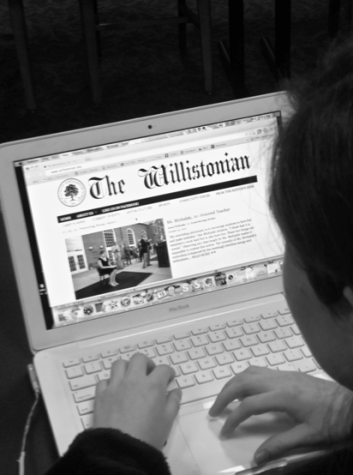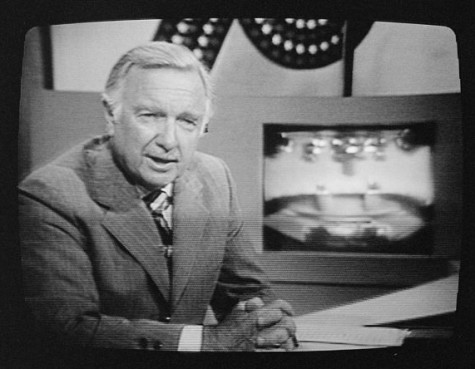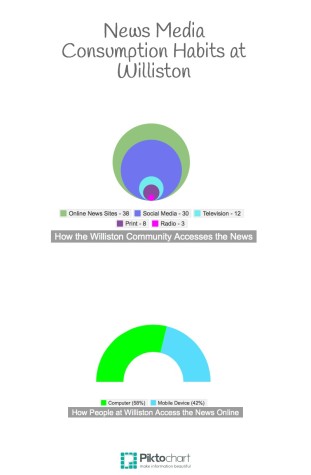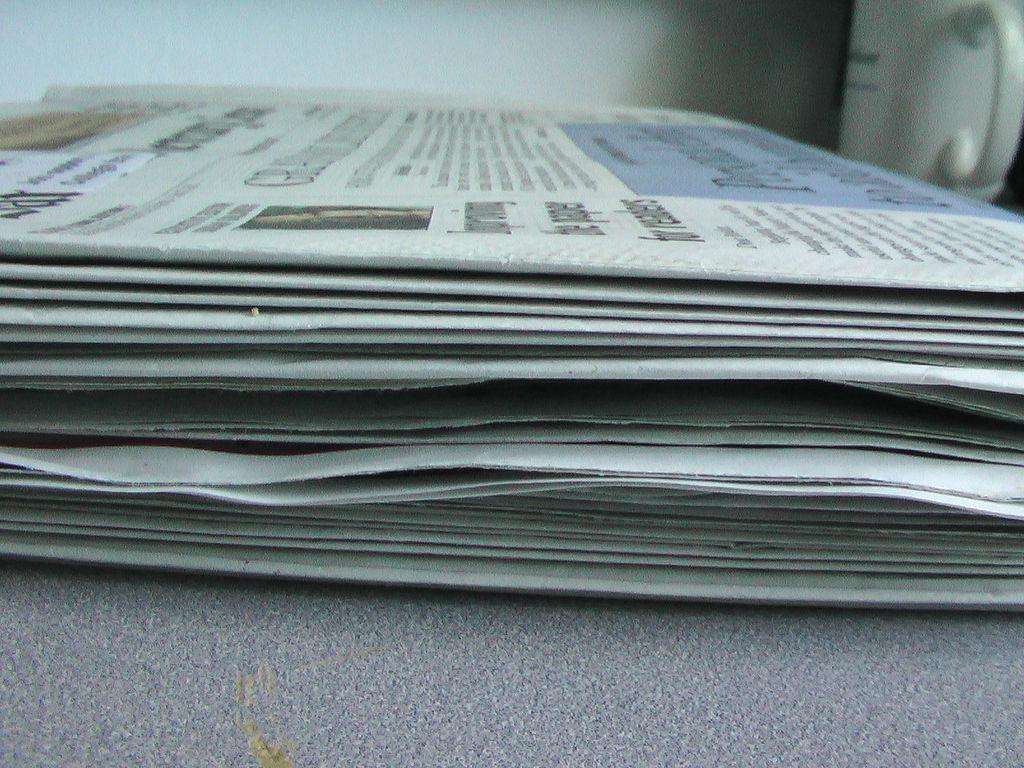The Future of News
January 27, 2015
People have always wanted to know the news. Since we developed speech, we have told stories, talked about our lives, told others where to find the best patches of blueberries. From the local town crier to the first printing presses to the radio and television, how we share and access the news has changed immeasurably throughout the centuries.
Now, in our Digital Age, we are witnesses to yet another shift.

Senior Katie Murray looks at The Willistonian’s website. Our paper, like so many others, now publishes online as well as in print.
According to PEW Research Journalism Project’s 2014 State of the News Media report, over 80% of Americans now access the news in a digital format. Our mobile phones give us instant access to information about what is going on across the globe. Sites like BuzzFeed and The Huffington Post gather entertainment articles and hard news and put it all together at our fingertips, and have expanded to include original news reports. Our Twitter feeds are inundated by flashes of the news. But all this access doesn’t mean we are taking advantage of this information.
With so much material to sort through, it is sometimes difficult to find what is important, relevant, and accurate.
Says Madeleine Blais, Professor of Journalism at the University of Massachusetts Amherst, “With the advent of computers and the Internet the way in which media delivered information imploded. In the old days a newspaper came out every twenty-four hours. There was no such thing as a twenty-four hour news cycle. It used to be that only highly trained people knew what a font was. Reporters were special because they had a gift for tracking down arcane information pre-Google.”
Now everyone has access to that information, and, contends Marc Fisher in the Columbia Journalism Review, “What’s news is what’s out there, whether or not it’s been checked and verified.”
News in 140 Characters: Twitter, Facebook, and How We Get the News in the Internet Age
According to an October 2013 article by the PEW Research Journalism Project, half of Twitter users get news on the site and over 30% of all adults in the United States were found to consume news through their Facebook feeds, although “most U.S. adults do not go on Facebook seeking news out.”
However, according to the October 2014 article “How Facebook is Changing the Way its Users Consume Journalism” in The New York Times, Facebook “drives up to 20 percent of traffic to news sites.”
Nearly half of the participants in the PEW study who follow the news only slightly considered Facebook an important way to access the news. Further, PEW Research discovered that those who access the news from Facebook are less engaged with the news site than those who access the site directly.
More importantly, news consumption habits have become more sporadic, rather than occurring at regular intervals as they would by, for example, watching the nightly news or reading the morning paper. With mobile devices and the availability of the news online, consumers can access the news whenever they want to.
The PEW Research Center for People and the Press refers to this habit of checking the news at irregular times as “grazing” and found in a September 2012 study, “Nearly eight-in ten (79%) of those 18 to 29 graze the news during the day.”
 Via Wikimedia Commons under Fair Use
Via Wikimedia Commons under Fair Use
BuzzFeed, a digital native news site founded in 2006, is a prime example of the news consumption habits that dominate the New Media Age. What started out as a quiz-filled, list-laden, click-bait site has become a source of hard news. Interactivity is the word at BuzzFeed; along with quizzes, among the most appealing BuzzFeed features are the “OMG,” “WTF,” “Win,” and “Fail” buttons, among others, that users can press in reaction to an article, list, or quiz on the site.
BuzzFeed features listicles, articles formatted as lists, amateur videos, and photos galore. This structuring has proved immensely appealing to a public with an attention span used to reading updates in 140 characters or fewer on Twitter.
BuzzFeed, writes Douglas Quenqua in his February 2013 article on the site’s Editor-in-Chief, Ben Smith, for The New York Times, “operates on the philosophy that social media sites like Facebook and Twitter are America’s new front pages and that the content people view online is determined more by what their friends share than what is found on the home page of a news organization.”
However, Quenqua also points out that BuzzFeed has successfully reported on political campaigns and published thought provoking investigative articles, and says, for BuzzFeed, “The distinction between Web ephemera like baby videos and traditional journalism has all but disappeared.”
BuzzFeed was named “The Defining Media Outlet of 2012” by The New Republic, and according to David Rowan in a January 2014 article for Wired, BuzzFeed announced that it had reached 130 million unique visitors in the month of December 2013.
What is News Today?
Ann Hallock, Editor-in-Chief at FamilyFun magazine, says that in today’s magazine industry, “We look for really original, fresh ideas… finding non-copyrighted, original ideas has become much more difficult.” Her colleague Jon Adolph, Executive Editor of the same magazine, similarly asserts that the news “used to be much more centralized” with “monopolies in [television], radio, [and] newspaper,” but with the advent of the Internet, news is “much more decentralized… [Now,] everyone is a reporter.”
News is no longer only a report of political outcomes and military maneuvers. It is “21 Things Girl-Guy Friends Just Get” and “Jaden and Willow: On Another Level.” More traditional news sources like CNN have turned to the use of additional images and lists, mimicking BuzzFeed, with pieces like “What a Shot! 39 Sports Photos” and “5 People You Should ‘Unfriend’” alongside articles about racial tensions in Ferguson, Missouri and updates on freezing winter weather.
Giving people what they want as opposed to what they should want is a conflict as old as journalism.
— James Fallows
In April 2014 James Fallows wrote for The Atlantic that Gawker, another digital native whose tagline reads “Today’s Gossip is Tomorrow’s News,” has found as a niche “knowing exactly what an audience wants to see and read, as opposed to someone’s opinion of what it should want or ‘needs’ to know.”
He continues, “Giving people what they want as opposed to what they should want is a conflict as old as journalism.”
Today’s news is indeed dominated by what we, the consumers, want. It is for this reason we see entertainment articles about Beyoncé and One Direction featured as prominently as investigative reports on the crisis in Syria.
Says Ms. Hallock of social media and the news, “At every moment of every day, you can be getting news… the social aspect is huge.” However, she cautions that finding the news through sites like Twitter and BuzzFeed is like “eating a lot of junk food.”
Ms. Hallock says, “You don’t feel smarter looking at BuzzFeed.”
So, is there a Right Way to Get News?
The famous journalist Edward R. Murrow likely had no idea how prophetic he was when he said in 1964, “The speed of communications is wondrous to behold. It is also true that speed can multiply the distribution of information that we know to be untrue.”
In 2010, Ted Koppel, anchor of Nightline for 25 years, wrote about “The Case against News we can Choose” for The Washington Post.
He argued that the bygone world of traditional television news media was one where television “networks considered the collection and dissemination of substantive and unbiased news to be a public trust” and “while Walter Cronkite, Chet Huntley, David Brinkley, Frank Reynolds and Howard K. Smith offered relatively unbiased accounts of information that their respective news organizations believed the public needed to know…It was an imperfect, untidy little Eden of journalism.”

Walter Cronkite on television in 1976.
Today, wrote Koppel, “The need for clear, objective reporting in a world of rising religious fundamentalism, economic interdependence and global ecological problems is probably greater than it has ever been. But we are no longer a national audience receiving news from a handful of trusted gatekeepers; we’re now a million or more clusters of consumers, harvesting information from like-minded providers.”
Ms. Hallock agrees, saying, in the past, “news was handed down to you [and] ‘high authorities’ told you what the news was.” She says that now, it is “almost more like you have to be your own editor of information” and you “can be your own guide.”
Mr. Adolph argues that you have to be more careful in your consumption of news media, saying, “Young people are always getting wave upon wave of information, now whether or not that information is informed and helpful is another question. You really need to have a curated experience where knowledgeable people are deciding ‘what’s the news.’”
Nevertheless, in a world where social media is the norm, it is unlikely consumers will ever again have a truly “curated experience” of the news.
Does New Media do anything for Traditional Media?
Short answer, yes.
Professor Blais says, “I almost don’t think there is any Traditional Media any more, or at least not any that isn’t intimately connected to New Media.”
Traditional media sources have had to adapt to a changing culture, but New Media allows for daily, to-the-minute online publications instead of print publications at specified times. The news can be updated immediately, which means consumers have access to the latest information.
Ms. Hallock says of New Media, “In some ways, people are more informed in a sort of headline way. They know what’s going on slightly more because of New Media” although they may not “know very much about it.”
Mr. Adolph sums it up: “You have to go out of your way to be unaware,” because “the resources are there to be an incredibly informed citizen, a citizen of the world.”
What about Williston?

Here at Williston, 75% of participants in a survey about news consumption habits said they primarily access the news online, and 43% of responders said that they tend to use a mobile device when checking online news sources.
With a wireless-networked campus, this statistic comes as no surprise. Students and faculty alike are almost constantly connected to the Internet with our tablets, computers, and smartphones. With the importance of our emails, OneNote, and assignment postings on Veracross, it would be nearly impossible to succeed at our school without the Internet.
Even our school newspaper, The Willistonian, has an online presence. Our website and Facebook page are updated regularly and links to our articles regularly appear in “On the Quad” emails to the community.
Nevertheless, The Willistonian continues to put out several print editions every year, which you should absolutely read.
Why Should We Care?
Even as it changes, the news is still a defining aspect of our culture and our humanity. We are curious creatures, and to know the news is to be connected to ideas and people across the globe. When we share information and viewpoints, the world slowly shrinks.
A quotation often attributed to the late nineteenth century British publisher Arthur Harmsworth, Lord Northcliffe, reads, “News is what somebody somewhere wants to suppress; all the rest is advertising.”
In an age where information is everything, the news is getting ever harder to subdue.
